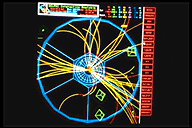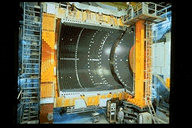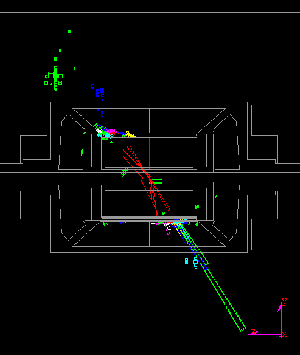
Particle physics experiments today generally contain a variety of different detectors,
each with a specialised task to aid the identification and measurement of particles. Close
to collision point, tracking detectors reveal the paths charged particles take as they fly
away.
 |
A magnetic field often bends the paths of the particles, to allow their momentum to be measured. The amount of bending varies with momentum of the particle: very high momentum particles travel in almost straight lines, low momentum particles make tight spirals. |
| Detectors called calorimeters are used to measure particle energies, and are designed to stop most neutral particles as well as charged ones. Different kinds of calorimeter are usually needed for electrons and photons, and for protons, neutrons, pions and other particles built from quarks (hadrons). |  |
Combining measurements of momentum, energy and sometimes speed allows particles to be
identified.
 |
Muons and neutrinos are often the only particles capable of reaching the detectors furthest from the collision point, after passing through the rest of the experiment. Signals in the outer detectors therefore usually indicate the presence of muons. Neutrinos, by contrast, escape all the detectors undetected. However, as the neutrinos are the only particles that can escape, their presence can be inferred from an imbalance between the incoming and outgoing energy and momentum. |
© Copyright CERN - Last modified on 1997-12-04 - tradotto da Sofia Sabatti